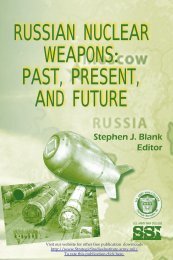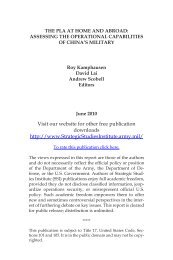The United States and China in Power Transition - Strategic Studies ...
The United States and China in Power Transition - Strategic Studies ...
The United States and China in Power Transition - Strategic Studies ...
Create successful ePaper yourself
Turn your PDF publications into a flip-book with our unique Google optimized e-Paper software.
Will <strong>Ch<strong>in</strong>a</strong> follow the example of U.S. President James<br />
Monroe (the 5th President from 1817 to 1825) <strong>and</strong> assert<br />
a sphere of <strong>in</strong>fluence <strong>in</strong> East <strong>and</strong> Southeast Asia?<br />
Will the rise of <strong>Ch<strong>in</strong>a</strong> come at the expense of U.S. core<br />
<strong>in</strong>terests <strong>in</strong> this region?<br />
<strong>The</strong>se questions are underst<strong>and</strong>able, but the concerns<br />
are not necessary for at least three ma<strong>in</strong> reasons.<br />
First, the Ch<strong>in</strong>ese know that it is not practical.<br />
Dai B<strong>in</strong>gguo ridiculed the idea of a Ch<strong>in</strong>ese version<br />
of Monroe Doctr<strong>in</strong>e <strong>in</strong> his remarks mentioned earlier.<br />
Indeed, <strong>in</strong> the next 30 years, <strong>Ch<strong>in</strong>a</strong> still needs to carefully<br />
h<strong>and</strong>le relations with its Asian neighbors so that<br />
<strong>Ch<strong>in</strong>a</strong> can cont<strong>in</strong>ue its modernization mission, rather<br />
than try<strong>in</strong>g to become a “boss” <strong>in</strong> this region.<br />
Second, the nations <strong>in</strong> Asia will not accept a Ch<strong>in</strong>ese<br />
Monroe Doctr<strong>in</strong>e either. Unlike the weak nations<br />
<strong>in</strong> Central <strong>and</strong> South America of President Monroe’s<br />
time, many of <strong>Ch<strong>in</strong>a</strong>’s Asian neighbors are formidable<br />
powers. Japan, <strong>in</strong> particular, is not quite ready to yield<br />
its lead<strong>in</strong>g position <strong>in</strong> Asia to <strong>Ch<strong>in</strong>a</strong> yet. Of note is<br />
that almost all of the East <strong>and</strong> Southeast Asian nations<br />
want the <strong>United</strong> <strong>States</strong> to stay engaged <strong>in</strong> this region.<br />
It is a widely-shared view that the nations <strong>in</strong> Asia-Pacific<br />
want the <strong>United</strong> <strong>States</strong> to ma<strong>in</strong>ta<strong>in</strong> security <strong>and</strong><br />
order <strong>in</strong> this region <strong>and</strong> serve as a countermeasure<br />
aga<strong>in</strong>st <strong>Ch<strong>in</strong>a</strong>. 216<br />
F<strong>in</strong>ally, the U.S. alliance <strong>and</strong> coalition network <strong>in</strong><br />
the Western Pacific is solid. It is stable <strong>and</strong> powerful<br />
enough to ma<strong>in</strong>ta<strong>in</strong> the U.S.-led regional order <strong>in</strong> the<br />
years to come. <strong>Ch<strong>in</strong>a</strong> is underst<strong>and</strong>ably uncomfortable<br />
with this U.S.-led “encirclement;” but it has no reason<br />
to be paranoid. <strong>The</strong> U.S. effort is part of its “hedg<strong>in</strong>g”<br />
strategy to guard aga<strong>in</strong>st a <strong>Ch<strong>in</strong>a</strong> that might turn aggressive,<br />
but not a strategy to conta<strong>in</strong> or attack <strong>Ch<strong>in</strong>a</strong>.<br />
<strong>Ch<strong>in</strong>a</strong> can use its economic power to attract the<br />
Asian nations. But <strong>Ch<strong>in</strong>a</strong> should bear <strong>in</strong> m<strong>in</strong>d that it<br />
183

















